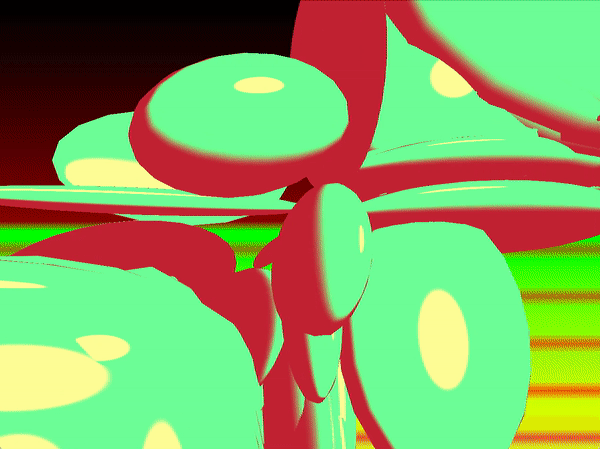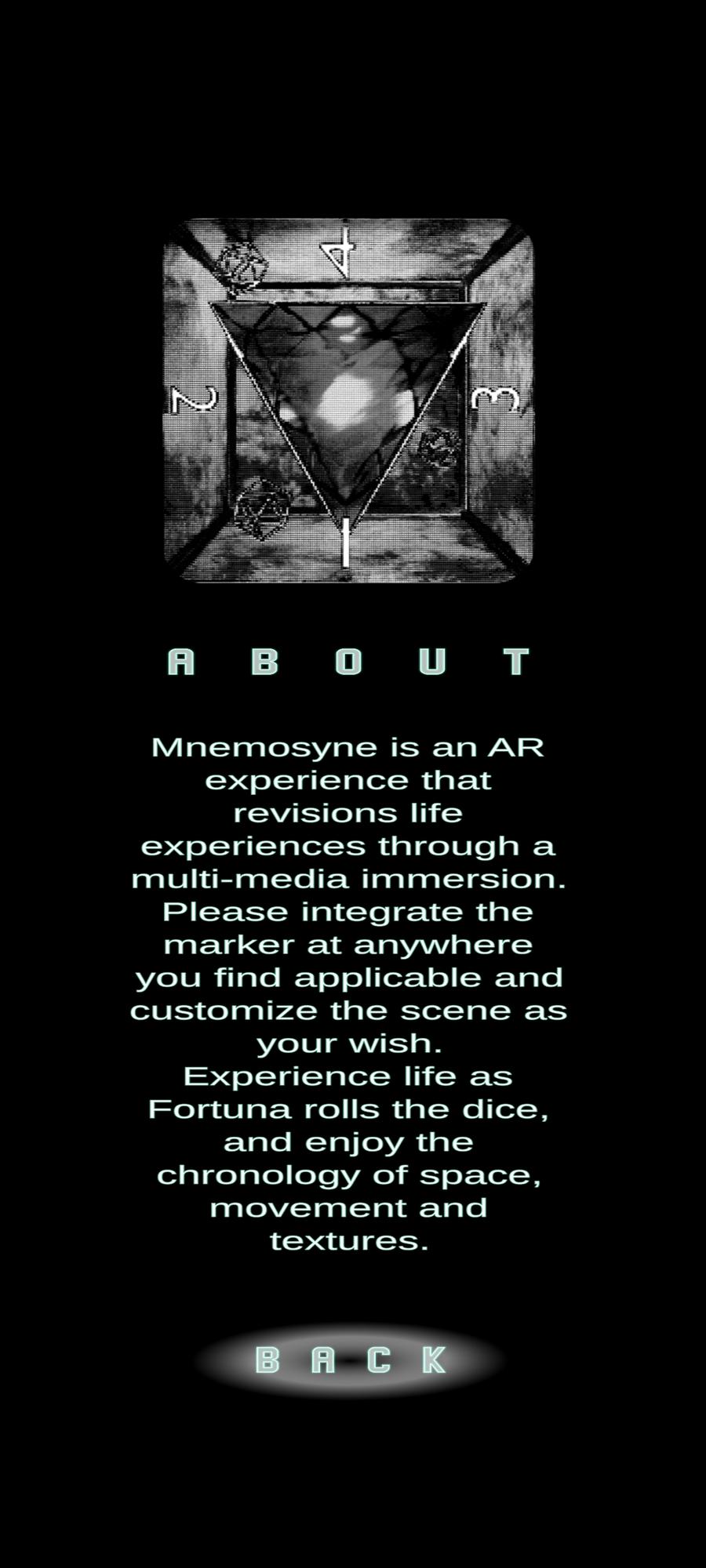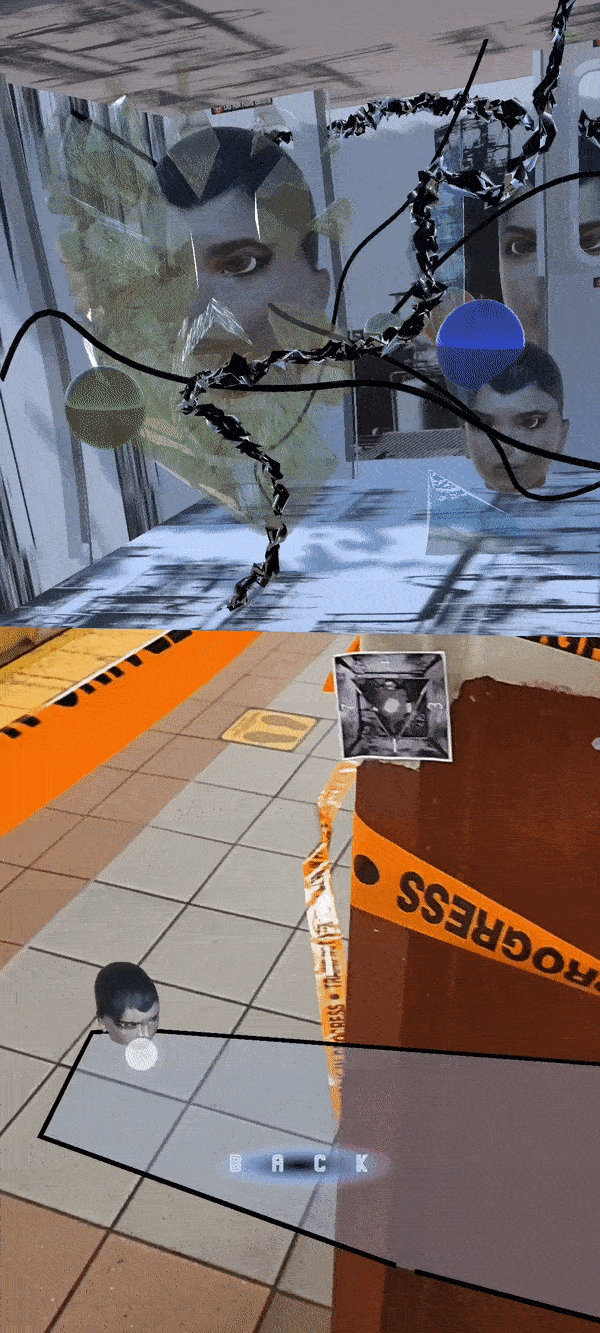
Generative Visual Practice, 2022
Mnemosyne: A Visual Exploration of Memory and Reality in AR
An Interview with Jun(Runqi) Zhou
Apr 20th, 2023
Jun Zhou was born and raised in Beijing and holds a BA degree from NYU Gallatin School of Individualized Study with a concentration in Cyberspace Narrative. Her academic exploration revolves around media theories, interactive media arts, film, and computing. She examines the existence of individuals within society and the world, including self-identity, connections with others, mental/physical perception, and the influence of the internet/media, from a media and information perspective. Her works create experiences and narratives by organizing information and producing multimedia content.
https://junzhou.info/
Can you tell us about your background and how it has influenced your work?
I was born and raised in Beijing and basically grew up with culture of television, film screen, and computer since I had memory, which made me exposed to a wide range of things. While I wasn't sure where my interests lay in high school, I chose to study at NYU Gallatin, where I could freely explore different departments such as film, philosophy, computer science, and cultural studies. The interdisciplinary academic and artistic practices during my undergraduate studies fueled my curiosity about different media and theories. As a result, I developed a mindset that it's always possible to learn something new from scratch. This background also instilled in me a belief that knowledge and experience from different realms can be integrated and applied to create a cohesive work that reflects the unique perspective of the creator.
What inspired you to focus on media theories, interactive media arts, film, and computing?
My interest in these topics comes naturally as I explore different disciplines. I discovered my fascination with the process of accumulating, fabricating, and transmitting information during my sophomore year. This fascination helped me connect my practices and research.
To me, the boundaries between media arts, filmmaking, and computing are ambiguous as they all involve ideating a concept, gathering necessary materials, forming a function or methodology, and turning those into an output. Although the agency varies between them, I find similarities in their inner logic, and enjoy the refreshment I get by switching my focus. I use theories to recharge myself between my practices, as I need to maintain a critical and flexible way of thinking to switch between different realms and reflect on myself. I particularly enjoy exploring the resonance between theories and artworks produced in different times and cultures, which confirms that we live in a non-linear nexus of information.
The Unlikely Journey of Inch Ichi, Short Film 2021
What inspired you to create Mnemosyne, and how did you come up with the idea for this project?
My inspiration for Mnemosyne comes from my research fellowship on virtual identities last summer. During this fellowship, I examined the concept of virtual identities in art and media throughout history and how digital technologies enhance their existence. This gave me the chance to investigate the concept and technologies of XR, and I learned to make several demos of myself. As I researched the topic, I found the concept of AR to be more fascinating than other approaches. AR indicates an overlapping state between reality and the virtual through digitalization, while VR leads to pseudo-immersion by temporarily cutting off perceptions of reality. I consider AR a more inclusive concept that could be applied to many scenarios, as a non-technological definition of augmented reality already exists in our lives. This understanding is the starting point for ideating Mnemosyne and has led me to seek possibilities of organically combining AR technology with life experiences. I draw inspiration from theorists such as Manuel Delanda and Sandy Stone, as well as artists like Anish Kapoor and Richard Serra.
Original Avatar Y
Could you please walk us through the 4 chapters of Mnemosyne and what kind of scenes users can expect to see in each chapter?
The chapters in this work are assigned different color codes, which opens them up to individualized interpretations rather than limiting their possibilities. The first chapter presents a subway-like scene with a cold-toned palette. Enclosed in a box, repetitive head figures are accompanied by floating fragments and lines. The faces in this chapter are AI-generated human portraits that have been post-processed into textures, with geometric meshes occupying the space between them. The second chapter has a more cheerful vibe, featuring several vessels swinging back and forth with colorful beams surrounding them. When a series of containers are placed in one spot, they perform a continuous rhythm that goes on ceaselessly. The third chapter presents a twisted beating heart that channels towards a world of noise that echoes with some acid aesthetics. The fourth chapter takes place in a serene water realm, in which each ripple generates a self-automated paper airplane.




Can you explain the core concept of Mnemosyne and how it is different from other AR experiences?
Mnemosyne is named after the Greek goddess of memory and was inspired by Aby Warburg's art history work, Bilderatlas Mnemosyne. This collection of wooden panels with pinned images traces patterns and themes established throughout the history of visual creations, capturing the dynamics in the representation of life. Although I am not a professional and did not scrutinize this project, I was intrigued by the concept and metaphor of Mnemosyne as a pathway to consider the cultural and historical influence of visual compositions.
Bilderatlas Mnemosyne
Technologically speaking, Mnemosyne consists of a series of image-detection AR experiences that are commonly seen in exhibitions. However, I didn't create Mnemosyne for a specific situation, nor do I consider it a one-time spectacle for people to glance at and then move on. I intentionally omitted specific information that would match real locations and events within the scenes, instead opting for a set of vague virtual objects. Most of the assets were originally modeled and shaded by myself with a degree of randomness involved, as I wanted these scenes to be situated in reality spontaneously and intuitively.
The logo and marker of Mnemosyne
How did you approach designing the Mnemosyne app, and what considerations did you make for user experience and interface design?
I started to think of designing as an extension of my AR creations, with the ultimate goal of making the project accessible . I realized that the limited accessibility and usability of not only my creations, but also other technologically-driven projects, could be attributed to the audience's lack of understanding and technological knowledge. Many XR works are known to people through video and image documentation, and from this perspective, the XR experiences presented in a video are not significantly different from videos or animations with special effects. This realization inspired me to conceive of a platform that brings XR creations to life, rather than simply existing within a video recording. Despite having no prior experience in mobile app design, I approached this as an experiment rather than a professional design. I invested considerable time in observing the apps I used for content creation and sharing, analyzing their information structures and layout designs. Although this is not an actual app and similar products may not emerge in the future, my hope is that the design conceptualizes something accessible and user-friendly, enabling users to enter the realm with minimal barriers.
The mind map
Could you please discuss your perspective on the existence of the individual within society and the world, particularly in terms of self-identity, connection with others, and mental/physical perception?
This is a broad topic. In the context of my works, I consider people to be both placed and placing themselves in the network of the world. Each person is a multi-dimensional point, linking with many other points, so it's normal to coexist with multiple identities and definitions without feeling paradoxical; or feeling paradoxical is normalized. Both mental and physical perceptions are equally "real" to us, as they are two sides of the same coin. I also advocate for an object-oriented ontology, as I strive to avoid representations of specific human beings or communities in some of my works, but instead, focus on the interdependence between humans and non-human objects. Rather than viewing the world hierarchically and chronologically, I see it as rhizomatic and non-linear. An individual has no clear starting or ending point, but exists as a series of events within the grand system, and connecting with others is a way to delve into those intricate relationships.
Wissen, Interactive Installation, 2021
How does the Mnemosyne AR experience intersect with your broader artistic practice, and what other projects are you currently working on?
As I explore different media, I do not consider Mnemosyne as an indication of how my future practices will be in terms of forms and contents. I rarely define the scale and length of a project in the initial phase, preferring to discover that in a fluid process. I also have a tendency to reevaluate my past ideas and make extensions. However, Mnemosyne does reveal to me the possibility of connecting and consolidating different situations and narratives into one piece, which encourages me to focus on the often-overlooked micro-events and the inconspicuous aspects of the world, and to interpret them in my own way.
Currently, I am preparing several different projects, some of which are design-oriented, while others are technology-oriented, and I am still in the process of figuring out the proper form for these projects. I am also working on smaller-scale projects such as zines or videos. In addition to creation, I am also considering how to efficiently share experiences and knowledge, which is important to me at this stage.
Graphic experimentation for fun
What challenges have you faced in your work, and how have you overcome them?
Creating things at one's own pace and mindset is a tough process in comparison to learning or making according to existing samples. One challenge is to keep self-validating amidst the messy situations of life, as last year I needed to maintain my academic and social life while squeezing time to contemplate about my own projects. Making things in a class or in a school system sometimes helps me to keep in track and avoid procrastination, but it also limits my energy to spend on each part and do self-reflections, therefore making me question myself whether I could do better or do alternatively. Now my approach to overcome such confusions is trying to view my works without the exterior interference, and accept my intuitive thoughts, no matter if it's positive or negative. I also find talking with others about future perspectives and reflections helps.
Finally, what message or takeaway do you hope users will have after experiencing Mnemosyne, and how do you hope it will impact their relationship with public spaces and mixed reality technologies?
Personally, I find mixed reality technology to be a good complement to public spaces, as it allows for the digitization of a location's infrastructure and history. Such an innovation can bring about numerous conveniences and creative possibilities for people. However, I am also aware that the overindulgence in technology may numb our perception of reality, as depicted in Keiichi Matsuda's Hyper-Reality.
Hyper-Reality by Keiichi Matsuda
In Mnemosyne, I have deliberately avoided the cyberpunk aesthetic and ensured that the assets do not overwhelm the physical space. My intention is not to exaggerate virtuality over reality but to help people memorize events, dates, or locations with multi-media stimulus. I kept playing around with the scenes in various locations around New York City, which was quite fun. I guess this is my aspiration for this project: it will not deprive us of anything, but adds layers to the ephemeral moments.
Mnemosyne, AR, 2022

